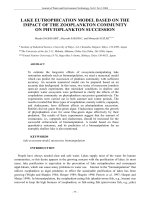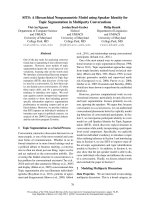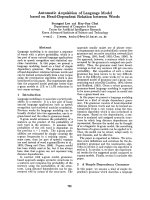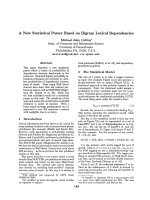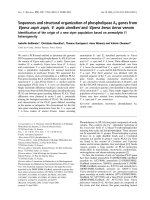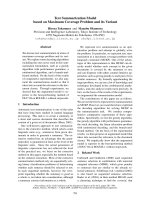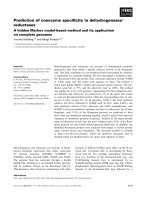A game theory model based on Gale-Shapley for dual-resource constrained (DRC) flexible job shop scheduling
Bạn đang xem bản rút gọn của tài liệu. Xem và tải ngay bản đầy đủ của tài liệu tại đây (1.57 MB, 12 trang )
International Journal of Industrial Engineering Computations 11 (2020) 173–184
Contents lists available at GrowingScience
International Journal of Industrial Engineering Computations
homepage: www.GrowingScience.com/ijiec
A game theory model based on Gale-Shapley for dual-resource constrained (DRC) flexible job
shop scheduling
Paolo Rennaa*, Matthias Thürerb and Mark Stevensonc
a
School of Engineering, Università degli Studi della Basilicata, Italy
Institute of Physical Internet, School of Electrical and Information Engineering, Jinan University (Zhuhai Campus), 519070, Zhuhai, PR
China
cDepartment of Management Science, Lancaster University Management School, Lancaster University, LA1 4YX, United Kingdom
CHRONICLE
ABSTRACT
b
Article history:
Received July 16 2019
Received in Revised Format
October 29 2019
Accepted October 29 2019
Available online
November 1 2019
Keywords:
Dual-resource constrained (DRC)
shops
Flexible job shop scheduling
Game theory
Gale-Shapley
Simulation
Most job shops in practice are constrained by both machine and labor availability. Worker
assignment in these so-called Dual Resource Constrained (DRC) job shops is typically solved in
the literature via the use of meta-heuristics, i.e. “when” and “where” rules, or heuristic
assignment rules. While the former does not necessarily lead to optimal results, the latter suffers
from high computational time and complexity, especially when there is a large number of
workstations. This paper uses game theory to propose a new worker assignment rule for DRC
job shops. The Gale-Shapley model (also known as the stable marriage problem) forms a
‘couple’ made up of a worker and machine following a periodic review strategy. Simulation is
used to evaluate and compare the proposed model to “when” and “where” rules previously
proposed in the literature. Simulation experiments under different conditions demonstrate that
the Gale-Shapley model provides better results for worker assignments in complex DRC
systems, particularly when the workers have different efficiency levels. The implications of the
findings for research and practice are outlined.
© 2020 by the authors; licensee Growing Science, Canada
1. Introduction
In recent years, the rapid introduction of new products with shorter life cycles have required shops to
adapt to rapid changes in the product mix and have driven firms towards adopting more flexible and
customized job shop manufacturing systems. Job shop manufacturing systems have been widely
investigated in the extant literature, but the majority of this research has considered only a single capacity
constraint, i.e. based on the availability of machines only. In practice however, these manufacturing
systems are typically constrained by two elements, i.e. by both machines and workers (Patel, 1997).
These so-called Dual Resource Constrained (DRC) systems have received limited attention in the
literature, where a job can only be processed if both a machine and a skilled worker is available. The
DRC shop modelled in the literature is characterized by the number of workers rather than the number
of machines, with the number of machines typically considered fixed. Since the number of workers is
normally less than the number of machines, worker reallocations amongst the machines are necessary.
* Corresponding author
E-mail: (P. Renna)
2020 Growing Science Ltd.
doi: 10.5267/j.ijiec.2019.11.001
174
In such a context, the assignment of workers to machines becomes highly relevant when searching for
improvements to manufacturing system performance. The job shop environment is not the only context
in which dual resource constraints occur. Hence, the DRC problem has been modelled in several other
applications, such as in hybrid push-pull control with a kanban system (Salum and Uraz, 2009), in cellular
manufacturing systems (Kannan & Jensen, 2004), in virtual cellular manufacturing systems (Hamedi et
al., 2012), and automobile assembly plants (Fredendall et al., 1996), in addition to call centers, field
service systems, serial production systems, manufacturing cells, etc. (e.g. Hopp & Van Oyen, 2004;
Nembhard, 2007). In this study, we focus on the job shop given the importance of short-term worker
assignment decisions in this context (Delgoshaei et al., 2017). The job shop scheduling problem is an
Np-hard combinatorial optimization problem (Lenstra & Rinnooy Kan, 1979). The DRC system is even
more difficult to solve than the job shop problem because of the presence of two resource constraints. It
therefore becomes difficult to use analytical approaches and there are high computational costs. As a
consequence, the use of meta-heuristic methods has been widely proposed in the literature (El Maraghy
et al., 2000; Li et al., 2016; Li & Lang, 2011). The scheduling problem in DRC systems is resolved via
“when” and “where” rules; the when rule determines the timing of when a worker is considered for
transferal between machines while the where rule determines the machine to which the worker should be
transferred (Bokhorst et al., 2004). Often however the meta-heuristic is unable to find a near optimum
solution (Li et al., 2016). There is thus a trade-off between computational time and near optimality.
In response to the aforementioned trade-off, this study proposes and evaluates the use of game theory for
assignment problems in DRC shops. More specifically, we argue that the assignment problem of workers
to machines can be adapted to the so-called ‘stable marriage problem’ studied by Gale and Shapley
(1962). The problem is based on considering n men and m women, where each person has ranked all
members of the opposite gender in order of preference. The preference of the persons is hereby translated
to the characteristics of the workers (as efficiency) and machines (as the parts in the queue). The “when”
rule follows a periodic review strategy while the “where” rule is based on the Gale-Shapley algorithm
(Gale & Shapley, 1962). The algorithm is adapted to the asymmetry of the number of workers and
machines and appropriate preference functions are defined. The Gale-Shapley algorithm allows the time
to take the decision and to obtain a suitable configuration to be reduced, including in the context of largesized problems. We therefore suggest that it could enable the computational complexity of the DRC
problem to be reduced and that it could be applied to various DRC systems, including the DRC job shop.
We use simulation to assess its performance compared with the meta-heuristics most typically applied in
the literature.
The remainder of this paper is organized as follows. Section 2 discusses the literature on worker
assignments in DRC systems and outlines the research questions that motivate our study. Section 3
describes the manufacturing system context investigated and the proposed model, based on game theory.
The simulation model used to evaluate performance is then described in Section 4 before the results are
presented in Section 5. Finally, conclusions, managerial implications and future research directions are
provided in Section 6.
2. Literature Review
Most of the contributions presented in the extant literature on worker assignments in DRC shops have
focused on “when” and “where” rules and proposed meta-heuristic and heuristic approaches. Some
examples studied the production planning problem in DRC manufacturing systems (El Maraghy, 2000)
using Genetic Algorithm (GA) with different algorithms to improve the solution as grey simulation
technology and non-dominated sorting GA II (Li 2011), branch population to accumulate and transfer
the evolutionary experience of parent chromosomes via pheromone (Li et al., 2006). The advantage of
GA lies in its global optimization ability while the disadvantage of GA is its low local search ability and
the time it takes to obtain the solution following several iterations. Araz and Salum (2010) proposed a
real-time scheduling approach to select a predetermined scheduling rule in DRC manufacturing systems.
P. Renna et al. / International Journal of Industrial Engineering Computations 11 (2020)
175
The model needs the combination of Artificial Neural Networks, fuzzy inference system and simulation
to provide the knowledge base. The main limitations of this methodology are the predetermination of the
rules and the accuracy of the Artificial Neural Network model. Several heuristic models have also been
proposed, such as the variable neighborhood search approach by Deming and Guo (2014). Meanwhile,
Mehravaran and Logendran (2013) developed a linear mixed-integer mathematical model and three metaheuristic algorithms to solve a bi-criteria non-permutation flow shop with dual resources and sequencedependent setup times. Zhang et al. (2017) proposed a hybrid discrete particle swarm optimization
algorithm to solve the DRC job shop scheduling problem with resource flexibility. The computation time
is a critical issue that limits the application of this method. Zheng and Wang (2016) proposed a
knowledge-guided fruit fly optimization algorithm with a new encoding scheme to solve the DRC
flexible job shop problem with a makespan minimization criterion. Meanwhile, Sammarco et al. (2014)
used a simulation based on agent system modelling to study the effect of several factors (i.e. workforce,
distance, buffer capacity, when rule, and where rule) on performance measured in terms of work-inprocess (WIP), flow time, and production rates. The introduction of DRC in cellular manufacturing
systems was studied by Satoglu and Suresh (2009) for the design of hybrid cellular manufacturing
systems and in Hamedi et al. (2012) for virtual cellular manufacturing systems. They proposed
mathematical models to design the cellular manufacturing systems, including the labor assignment
problem. However, these models were static because they considered the design problem only. Finally,
some models have been developed to be applicable in large-scale contexts or to make scheduling
decisions in real-time. For example, Lobo et al. (2013a, 2013b) studied the assignment of each worker
to a specific machine group in a DRC job shop to minimize the maximum lateness of jobs. Lobo et al.
(2014) then revised the approach of Lobo et al. (2013b) for the application of large-scale problems with
tractable computational complexity.
2.1 Assessment of the Literature
Xu et al. (2011) provided an overview of prior work on DRC systems and discussed some possible
approaches and future directions for solving the resource scheduling problem in a DRC system. The
authors argued that improved performance could be achieved via the use of a dynamic control system
that is able to find, in real-time, the best dispatching rule to use based on the current shop state and
aggregate performance for chosen performance measures (Araz, 2005, 2007; Araz & Salum, 2008).
Nevertheless, the meta-heuristic methods are also more flexible than simple heuristic assignment rules
in terms of scheduling ability, which makes future research in this area relevant. The main limits of the
literature on DRC systems concern the use of meta-heuristic or heuristic approaches with high
computational complexity, especially when the larger scale characteristics of real industrial cases are
considered. The mathematical models provided in the literature can be used in a specific context, but
they cannot be adapted to different industrial cases. Yet, it is also argued that the simple “where” and
“when” rules are unlikely to find near optimal solutions.
In response, we propose game theory as a novel approach for solving the worker assignment problem in
DRC job shops. Game theory approaches are widely used in the literature to solve scheduling problems
in different contexts, such as the parallel machine scheduling problem (Elisha et al., 2008; Opiyo et al.,
2009), Buscemi et al. (2012) addressed the job scheduling problem in heterogeneous computational grids
by exploiting the concept of Nash equilibrium, Li et al. (2012) presented integrated process planning and
scheduling in a manufacturing system and Sun et al. (2014) applied a non-cooperative game theory with
complete information to solve a flexible job shop problem. Meanwhile, Renna (2017) proposed a model
to support reconfiguration activities in job shop systems based on the Gale-Shapley model. The proposed
model based on game theory is solved in one step to take the decision and using limited information and
lower computational complexity. However, despite their promise, game theory models have not been
used to solve the worker assignment problem in DRC job shops. The Gale-Shapley Algorithm is
computationally easy to manipulate (Teo et al., 2011) and suitable for short-term decision; Therefore, the
first research question is:
176
RQ1:
Can the Gale-Shapley Algorithm be adapted to the DRC job shop problem under different
numbers of workers, workers’ efficiencies and inter-arrival times?
The second research question then asks:
RQ2: What is the performance improvement enabled by the Gale-Shapley Algorithm compared with
simple when and where rules?
Our first research question will be answered in the next section where the Gale-Shapley algorithm is
introduced. Then, a simulation model is developed to answer the second research question. The
performance of the proposed model is compared to classical “when” and “where” rules considering
different numbers of workers, worker efficiencies, and inter-arrival times.
3. Research context and Game model
The model considered is a randomly routed job shop (Conway et al., 1967) or pure job shop (Melnyk &
Ragatz, 1989; Oosterman et al., 2000). The manufacturing system consists of six workstations, and each
workstation consists of one machine. Each job is assigned a random routing sequence, the processing
time for each machine and the due date. The routing sequences assigned to jobs have an undirected flow.
The assumptions of the manufacturing system are as follows: operations cannot be pre-empted; each
machine can process only one task at a time; and, the queues are managed by the Earliest Due Date
(EDD) policy to improve lateness performance. In this research, the material handling time is included
in the machining time, and the handling resources are always available. The manufacturing system is
characterized by one bottleneck, as described in Section 4.
The notation is the following:
m =1,.., M is the index of the machines or workstations (the terms can be interchangeable);
i is the index of the generic part that enters the manufacturing system
aim =1 if the part i requires the operation of the machine m, 0 otherwise;
Topim is the process time of the part i in the machine m
WLm is the workload of the machine/work center m;
queuem is the processing time of the parts in the queue of the machine/work center m;
WLav is the average workload over all machines/workstations;
w=1,..,W is the index of the workers’ set;
Uw,m is the preference (Gale-Shapley model) of the worker w for the m machine;
Um,w is the preference (Gale-Shapley model) of the machine m for the w worker;
Effw,m is the efficiency of the worker w on the machine m;
Tp is the period time fixed to evaluate the reconfiguration of the machines.
3.1 Gale Shapley Algorithm (Renna, 2017)
This Section summarizes briefly the Gale- Shapley as reported also in Renna (2017). The Gale-Shapley
algorithm (Gale & Shapley, 1962) was developed to solve the stable matching problem in order to find
a stable match between two equal sets of elements, given an ordering preference for each element. The
algorithm defined two finite sets of players called the set of men (m) and set of women (w). Every
member of each set has preferences over the members of the opposite sex. At the start of the algorithm,
each m and w are free; the algorithm starts from the first m that chooses the most preferred w. If the
woman is free, then w and m become ‘engaged’. If the w is engaged to another m’, the w rejects the man
(m or m’) with the lower preference and becomes engaged to the man (m or m’) with the higher
preference. Then, the rejected man (m or m’) is free and proposes to their subsequent preferred women.
The algorithm is iterated until all men are engaged, the engaged pairs form the male optimal stable
matching set. This algorithm needs a number of steps that, in the worst case, is quadratic in n (that is, the
number of men), and it guarantees that if the number of men and women coincide and all participants
express a strict order over all the members of the other group, everyone gets married, and the returned
matching is stable. A pseudo-code that briefly explains the algorithm is the following:
177
P. Renna et al. / International Journal of Industrial Engineering Computations 11 (2020)
GALE-SHAPLEY (Set M, Set W)
while there is an unmarried man, m do
m chooses the first woman w on his preference list that he has not proposed to yet and proposes to her
if w is unmarried or prefers m over her current partner m′ then
w divorces m′ and w marries m
3.2 The Gale-Shapley Model
The approach proposed supports the allocation of workers to machines following a periodic review
strategy. The machines and the workers need to be divided into men and women according to the GaleShapley algorithm: the women are workers and the men are the machines. Then, the function to compute
the preference among the members of the two sets will be defined. When a job enters the manufacturing
system, the routing (aim) and process time (Topim) is assigned to the part as described in the simulation
model section below. Then, the workload of the machines is updated, as shown in Eq. (1):
(1)
𝑊𝐿 = 𝑊𝐿 +
𝑇𝑜𝑝 ∗ 𝑎
The workload of the machine m is reduced by the Topim when the part i leaves the machine m after the
process ends. The preferences of the women (workers) are computed as shown in Eq. (2) as follows:
𝑈
,
= 𝛼 ∙ 𝑞𝑢𝑒𝑢𝑒 + 𝛽 ∙ 𝑊𝐿
(2)
where, and are the weight comprises (0,1) and + =1. The preference of the workers is higher
for the machine with the most urgent job in the queue and highest workload. The workload considers
jobs at other machines that will visit the machine m. The preferences of the men are the efficiency of
the workers, as shown in Eq. (3):
𝑈
,
= 𝑒𝑓𝑓
,
(3)
If the workers have the same efficiency, the preference for the machines is the same.
3.3 Benchmark Model
The benchmark model to compare the proposed approach is based on a decentralized “when” rule because
the Gale-Shapley algorithm can operate only as a decentralized rule. In other words, all operations at a
station have to be completed before a worker can be reallocated. While this rule is outperformed by
decentralized rules (Thurer et al., 2018) if worker transfer costs or delays are not considered, it leads to
substantially lower worker movements or reassignments. This makes it more suitable for many practical
situations. The “where” rule is based on the number of parts in the queue of the machines. Only one rule
is considered since there were no significant performance differences between rules in Thurer et al.
(2018).
4. Simulation Model
To evaluate the proposed model, when compared to the benchmark (“when”-“where” rules), the
following simulation model is developed. Table 1 reports the characteristics of the models tested (Thurer
et al., 2014a; Thurer et al, 2014b, Renna, 2015). The job shop consists of six workstations, and each work
center is characterized by one machine. A random routing sequence without any directed flow is assigned
to a job when it enters the manufacturing system. Then, the processing time and due date is assigned, as
shown in Table 1. The main assumptions of the manufacturing system modelled (as in previous studies)
are as follows: raw materials are always available; all jobs are accepted; operations cannot be pre-empted;
each machine can only process one task at a time; the queues are managed by the EDD rule (to improve
lateness performance); the material handling time is included in the machining time; and, the handling
resources are always available. The inter-arrival parameter is adapted to the number of workers available;
178
5 workers is the base; the other inter-arrival parameters are calculated by multiplying the base interarrival by (5/4) for the scenario with 4 workers and (5/3) for the scenario with 3 workers. All the models
are tested with Tp periodic review from 1 to 17 and only the best case is reported in the numerical results.
Four cases of workers’ efficiency are considered. In the first case, all the workers have the same
efficiency, then it is considered a difference of efficiency of 10%, 20% and 30% among the workers.
Several values of and are tested and only the best cases are reported in the numerical results.
Table 1
Model Characteristics
Number of machines
Inter-arrival
Number of Operations
Due Date
Processing time
no bottlenecks
Processing time bottlenecks
Tp
Workers’ efficiency
6 (1 bottleneck and 5 no bottlenecks)
EXPO: 0.7704 (H); 0.642 (M); 0.6099 (L) with 5 workers available
EXPO: 0.963 (H); 0.8346 (M); 0.7704 (L) with 4 workers available
EXPO: 1.284 (H); 1.156 (M); 1.0914 (L) with 3 workers available
Discrete Uniform [1,6]
(Number of Operations)*(Total processing time)*Uniform[5,10]
2-Erlang with mean 1
2-Erlang with mean 1.15 (utilization about 90%)
1,3,5,7,10,12,15,17
a)Efficiency all equals (EFF 1);
b) efficiency by uniform distribution [0.9-1.1] (EFF 2);
c) efficiency by uniform distribution [0.8-1.2] (EFF 3);
d) efficiency by uniform distribution [0.7-1.3] (EFF4).
The performance measures concern the following:
The ability to deliver the job on time is measured by the following indexes: the percentage of tardy
jobs; the standard deviation of lateness; and, the average lateness [unit time]. The standard deviation
of job lateness is a measure of how spread out a lateness distribution is. It is used as an indicator of
timing performance, i.e. it indicates how close the jobs are completed to their due dates.
The manufacturing system is evaluated based on:
Throughput [parts/unit time]; the total number of items processed/produced by the manufacturing
system over the simulation time period.
Average job-shop time [unit time]; it is the average time from the release time of the order in the
manufacturing system to the time the order exits the system.
Work In Process (WIP) [jobs]; it is the average total number of jobs in the system (the sum of the
queues and jobs in the machines);
Average Workload of the machines [unit time]; it is the average workload of a machine over the
simulation period;
Standard Deviation of the Workload of the machines [unit time]; it measures the distribution of the
workload of the machines. This performance is reported as the coefficient of variation.
The performance about the workload should be relevant to compare this research to approaches that
include also the workload control of the manufacturing system. The simulation length is 25,000 time
units. For each experimental scenario, a number of replications have been conducted that are able to
assure a 5% confidence interval and 95% confidence level for each performance measure. Each
combination of the experiment class is characterized by over 3,000 replications and about 12 hours of
computation time (4 GHz Intel Core i7 and 16 Gb RAM).
5. Results
Table 2 reports the Analysis of Variance (ANOVA) for the lateness performance (average, standard
deviations- DS and percentage of items) and Table 3 reports the Analysis of Variance (ANOVA) for the
system time, throughput, Work In Process (WIP), and Workload performance (average and standard
deviation - DS).
179
P. Renna et al. / International Journal of Industrial Engineering Computations 11 (2020)
Table 2
ANOVA Results - Delivery Performance
Source of variance
Lateness
Lateness DS
Lateness%
Efficiency
Inter-arrival
Workers
Efficiency*inter-arrival
Efficiency* Workers
Workers* inter-arrival
Error
Total
Efficiency
Inter-arrival
Workers
Efficiency*inter-arrival
Efficiency* Workers
Workers* inter-arrival
Error
Total
Efficiency
Inter-arrival
Workers
Efficiency*inter-arrival
Efficiency* Workers
Workers* inter-arrival
Error
Total
Sum of
Square
6050.000
4418.000
1303.000
5064.000
1338.000
1749.000
1678.000
21601.000
1899.800
1834.900
674.600
1107.100
724.700
1029.100
897.700
8167.900
2.886
1.123
0.259
0.433
0.233
0.094
0.103
5.133
Degree of
Freedom
3
2
2
6
6
4
12
35
3
2
2
6
6
4
12
35
3
2
2
6
6
4
12
35
Mean Square
F-value
P-value
2016.700
2209.000
651.600
844.000
223.000
437.300
139.900
14.420
15.790
4.660
6.030
1.590
3.130
0.000
0.000
0.032
0.034
0.231
0.056
633.300
917.500
337.300
184.520
120.760
257.280
74.810
8.470
12.260
4.510
2.470
1.610
3.440
0.003
0.001
0.035
0.086
0.226
0.043
0.962
0.563
0.129
0.072
0.039
0.024
0.009
112.260
65.740
15.110
8.420
4.540
2.750
0.000
0.000
0.001
0.001
0.013
0.078
Degree of
Freedom
3
2
2
6
6
4
12
35
3
2
2
6
6
4
12
35
3
2
2
6
6
4
12
35
3
2
2
6
6
4
12
35
3
2
2
6
6
4
12
35
Mean Square
F-value
P-value
3233.300
2952.300
578.100
869.900
333.700
506.900
148.100
21.830
19.930
3.900
5.870
2.250
3.420
0.000
0.000
0.049
0.005
0.109
0.044
0.000
0.188
1.242
0.000
0.000
0.012
0.000
0.500
112369.000
742144.000
1.010
2.230
7436.920
0.687
0.000
0.000
0.463
0.112
0.000
4851.000
6649.000
3683.000
1684.000
1008.000
1825.000
450.100
10.780
14.770
8.180
3.740
2.240
4.050
0.001
0.001
0.006
0.025
0.111
0.026
165.670
221.600
116.450
52.050
32.700
61.370
15.020
11.030
14.750
7.750
3.460
2.180
4.090
0.001
0.001
0.007
0.032
0.118
0.026
0.132
0.087
0.474
0.015
0.013
0.060
0.016
8.240
5.420
29.480
0.950
0.820
3.740
0.003
0.021
0.000
0.497
0.573
0.034
Table 3
ANOVA Results - Manufacturing System Performance
Source of variance
System Time
Throughput
WIP
Workload AV
Workload DS
Efficiency
Inter-arrival
Workers
Efficiency*inter-arrival
Efficiency* Workers
Workers* inter-arrival
Error
Total
Efficiency
Inter-arrival
Workers
Efficiency*inter-arrival
Efficiency* Workers
Workers* inter-arrival
Error
Total
Efficiency
Inter-arrival
Workers
Efficiency*inter-arrival
Efficiency* Workers
Workers* inter-arrival
Error
Total
Efficiency
Inter-arrival
Workers
Efficiency*inter-arrival
Efficiency* Workers
Workers* inter-arrival
Error
Total
Efficiency
Inter-arrival
Workers
Efficiency*inter-arrival
Efficiency* Workers
Workers* inter-arrival
Error
Total
Sum of
Square
9700.000
5905.000
1156.000
5220.000
2002.000
2028.000
1778.000
27788.000
0.000
0.376
2.485
0.000
0.000
0.050
0.000
2.911
14554.000
13299.000
7366.000
10108.000
6047.000
7300.000
5401.000
64075.000
497.000
443.200
232.900
312.300
196.200
245.500
180.300
2107.400
0.397
0.174
0.948
0.091
0.079
0.241
0.193
2.124
180
All main effects, except the efficiency for the throughput, and the majority of the two-way interactions
were shown to be statistically significant at α = 0.05. Detailed results will be presented next in Section
5.1 before a discussion of the results is presented in Section 5.2
5.1 Performance Assessment
The main performance measures are presented in the form of performance curves. The curves present
the percentage difference between the game theory and the benchmark for different settings in terms of
the number of workers, the inter-arrival time, and the efficiency of the workers (see Fig. 1 and Fig. 2).
Lateness (3 workers)
Lateness (4 workers)
Lateness (5 workers)
Lateness DS (3 workers)
Lateness DS (4 workers)
Lateness DS (5 workers)
Tardy % (3 workers)
Tardy % (4 workers)
Tardy % (5 workers)
Fig. 1. Performance Assessment - Delivery Performance
The ability to deliver the job on time is significantly improved by our new approach to worker
assignment. The average and the standard deviation of lateness (see Fig. 1) exhibit the same behavior.
The game theory approach leads to a significant reduction in lateness. The reduction is higher when
workers have a different efficiency level (EFF 2, 3 and 4). The inter-arrival parameter is of greater
importance when the number of workers is 5. In this case, each inter-arrival has a different trend on the
lateness. The percentage of tardy jobs (Tardy %, Fig. 1c) leads to the biggest improvement for the
efficiency of EFF 3 of the workers; when the number of workers is 5, the improvements are relevant only
when the efficiency of the workers is different. Meanwhile, in terms of the performance of the
manufacturing system (see Fig. 2), the system time, WIP level, and throughput of the parts through the
manufacturing system reduce with the proposed approach when the workers have different efficiencies.
Meanwhile, the coefficient of variation for the workload distribution across the machines of the
manufacturing system increases with the proposed approach.
P. Renna et al. / International Journal of Industrial Engineering Computations 11 (2020)
System time (3 workers)
System time (4 workers)
System time (5 workers)
Work in process (3 workers)
Work in process (4 workers)
Work in process (5 workers)
Workload average (4 workers)
Workload average (5 workers)
Workload coefficient of variation (4
workers)
Workload coefficient of variation (5 workers)
Workload average (3 workers)
Workload coefficient of variation (3 workers)
181
Fig. 2. Performance Assessment - Manufacturing System Performance
5.2 Discussion of Results
The proposed approach based on game theory improves all of the main performance measures analyzed;
the different efficiencies of the workers is relevant for the game model. The game model is robust because
all the conditions tested highlight better performances compared to the benchmark. When the number of
workers increases, the different efficiencies is more important and has a major impact on the ability to
obtain better results.
The parameters to set the game model are stable when the efficiency among the workers is significantly
different. A major advantage of the proposed model is its periodic when rule, which allows for better
planning in practice. In contrast, both a decentralized and centralized when rule may trigger a worker
movement at any moment in time. However, it is important to determine the best value of Tp in order to
obtain the improvement in performance shown. Table 4 reports the best value of Tp, and for each
simulation class. The simulation experiments show the efficiency of the workers is relevant for these
values. In particular, when the workers have a high difference of efficiency, the Tp tends to 5, to 1 and
to 0. Another important issue concerns the Tp value; the values of the Tp studied show that a low
difference of Tp from the best value dramatically reduces the performance. Therefore, a when rule that
leads to different values from the best Tp cannot be proposed in combination with the Gale-Shapley
algorithm.
182
Table 4
Best cases of Tp, and values
3 Workers
EFF 1
EFF 2
EFF 3
EFF 4
EXPO H
Tp=5; =0.8, =0.2
Tp=5; =1, =0
Tp=5; =1, =0
Tp=5; =1, =0
EFF 1
EFF 2
EFF 3
EFF 4
EXPO H
Tp=5; =1, =0
Tp=5; =1, =0
Tp=5; =1, =0
Tp=5; =1, =0
EFF 1
EFF 2
EFF 3
EFF 4
EXPO H
Tp=5; =1, =0
Tp=5; =1, =0
Tp=5; =1, =0
Tp=5; =1, =0
EXPO M
Tp=10; =0.8, =0.2
Tp=5; =1, =0
Tp=5; =1, =0
Tp=5; =1, =0
EXPO L
Tp=20; =0.9, =0.1
Tp=5; =1, =0
Tp=5; =1, =0
Tp=5; =1, =0
EXPO M
Tp=6; =1, =0
Tp=5; =1, =0
Tp=5; =1, =0
Tp=5; =1, =0
EXPO L
Tp=10; =1, =0
Tp=5; =1, =0
Tp=5; =1, =0
Tp=5; =1, =0
EXPO M
Tp=15; =1, =0
Tp=10; =1, =0
Tp=5; =1, =0
Tp=5; =1, =0
EXPO L
Tp=15; =1, =0
Tp=15; =1, =0
Tp=5; =1, =0
Tp=5; =1, =0
4 workers
5 workers
6. Conclusions
Manufacturing systems constrained by machine capacity and labor capacity are known as Dual Resource
Constraint (DRC) shops. Although a broad literature on DRC shops exists, the application of game theory
has not been investigated in this context. In response, our first research question asked: Can the GaleShapley Algorithm be adapted to the DRC job shop problem under different number of workers, workers’
efficiency and inter-arrival time? Our second research question then asked: What is the performance
improvement enabled by the Gale-Shapley Algorithm if compared to simple when and where rules? Using
simulation, we have demonstrated how the Gale-Shapley algorithm has the potential to significantly
improve DRC shop performance and that results are robust to changes in demand, the number of workers,
and different efficiencies among the workers. The model proposed allows labor efficiency information
to be included with a positive effect on performance when the efficiency among the workers is different.
Moreover, the robustness of the approach is demonstrated by the improvements obtained for all
performance measures considered and under different conditions of demand, the number of workers, and
different efficiencies among the workers.
6.1 Managerial Implications
The proposed model can handle fluctuations in manufacturing systems due to labor turnover,
absenteeism, different worker competences, etc. The model supports the assignment of workers to
workstations following a periodic review policy. The game model reduces the number of worker
movements compared to a centralized when rule that allows for worker re-allocation after each operation
completion. While the game model may increase the number of transfers compared to a decentralized
rule because it re-assigns all of the workers in the manufacturing system, it fixes the time when transfers
occur. Hence, transfers are only triggered at fixed intervals (i.e. at a shift change or lunch break), whereas
decentralized and centralized when rules may trigger a worker movement at any moment in time. The
manager can use simulation with the game model to pursue a given performance target, adapting
conditions such as the inter-arrival time to the number of workers available (absenteeism), or making
capacity adjustments, such as the temporary introduction of a new machine. The game model assures a
solution with low computational complexity is provided even when the number of workers and/or
machines increase.
6.2 Limitations and Future Research
A limitation of our study is that we assume workers are fully interchangeable, and we omit behavioral
factors such as learning and forgetting. The game model can include these features in the assignment
problem and future research could therefore take these features into account. Meanwhile, the only
performance measure that deteriorated in our study was the variation in the workload on the shop floor.
P. Renna et al. / International Journal of Industrial Engineering Computations 11 (2020)
183
Future research could therefore explore the interaction of the game model with workload control
mechanisms to stabilize the workload.
References
Araz, O.U. (2005). A simulation based multi-criteria scheduling approach of dual resource constrained
manufacturing systems with neural networks. Lecture Notes in Computer Science (including subseries
Lecture Notes in Artificial Intelligence and Lecture Notes in Bioinformatics), 3809. LNAI, 1047– 1052.
Araz, O.U. (2007). Real-time controlled multi-objective scheduling through ANNs and fuzzy inference
systems: The case of DRC manufacturing. Lecture Notes in Computer Science (including subseries Lecture
Notes in Artificial Intelligence and Lecture Notes in Bioinformatics), 4490. LNCS (PART 4), 973–976.
Araz, Ö. U., & Latif Salum, L. (2010) A multi-criteria adaptive control scheme based on neural networks and
fuzzy inference for DRC manufacturing systems, International Journal of Production Research, 48(1),
251-270.
Bokhorst, J.A.C., Slomp, J., & Gaalman, G.J.C. (2004). On the who-rule in dual resource constrained (DRC)
manufacturing systems. International Journal of Production Research, 42(23), 5049–5074.
Buscemi, M.G., Montanari, U., & Taneja, S. (2012). A game-theoretic analysis of grid job scheduling.
Journal of Grid Computing, 10,501–519
Conway, R., Maxwell, W. L., & Miller, L. W. (1967). Theory of Scheduling. Reading, MA: Addisson-Wesley.
Delgoshaei, A., Khairol, M., Ariffin, A., & Ali, A. (2017). A multi- period scheduling method for trading-off
between skilled-workers allocation and outsource service usage in dynamic CMS. International Journal
of Production Research, 55(4), 997-1039.
Deming, L., & Guo, X. (2014). Variable neighbourhood search for dual-resource constrained flexible job
shop scheduling. International Journal of Production Research, 52(9), 2519-2529.
Opiyo, E. T., Ayienga, E., Getao, K., Okello-Odongo, W., Manderick, B., & Nowé, A. (2008). Game theoretic
multi-agent systems scheduler for parallel machines. International Journal of Computing and ICT
Research, 1(1), 21-27.
ElMaraghy, H., Patel, V., & Abdallah, I.B. (2000). Scheduling of manufacturing systems under dual-resource
constraints using genetic algorithms. Journal of Manufacturing Systems, 19(3), 186-201.
Fredendall, L.D., Melnyk, S.A., & Ragatz, G. (1996). Information and scheduling in a dual resource
constrained job shop. International Journal of Production Research, 34(10), 2783-2802.
Gale, D., & Shapley, L.S. (1962). College admissions and the stability of marriage. American Mathematical
Monthly, 69, 1, 9-14.
Hamedi, M., Esmaieilian, G. R., Ismail, N., & Ariffin, M.K.A. (2012). Capability-based virtual cellular
manufacturing systems formation in dual-resource constrained settings using Tabu Search. Computers and
Industrial Engineering, 62, 953-971.
Hopp, W.J., & Van Oyen, M.P. (2004). Agile workforce evaluation: a framework for cross-training and
coordination. IIE Transactions, 36(10), 919–940.
Kannan, V.R., & Jensen, J.B. (2004). Learning and labour assignment in a dual resource constrained cellular
shop. International Journal of Production Research, 42(7), 1455-1470,
Li, J., Huang, Y., & Niu, X. (2016). A branch population genetic algorithm for dual-resource constrained job
shop scheduling problem. Computers and Industrial Engineering, 102, 113-131.
Li, H., & Lang, M. (2011). Research on dual-resource multi-objective flexible job shop scheduling
under uncertainty. In 2nd International Conference on Artificial Intelligence, Management
Science and Electronic Commerce (AIMSEC), Dengleng, China, 8-10 Aug. 2011.
Li, X., Gao, L., & Li, W. (2012). Application of game theory based hybrid algorithm for multi-objective
integrated process planning and scheduling. Expert Systems with Application, 39(1), 288–297.
Lenstra, J., & Rinnooy Kan, A. (1979). Computational complexity of discrete optimization problems, in
Discrete Optimization In Proceedings of the Advanced Research Institute on Discrete Optimization and
Systems Applications of the Systems Science Panel of NATO and of the Discrete Optimization
Symposium, Hammer, P., Johnson, E., and Korte, B. (eds), Elsevier, New York, NY, pp. 121–140.
Lobo, B.J., Wilson, J. R., Thoney, K.A., Hodgson, T. J., & King, R. E. (2014). A practical method for
evaluating worker allocations in large-scale dual resource constrained job shops. IIE Transactions, 46(11),
1209-1226.
184
Lobo, B. J., Hodgson, T.J., King, R.E., Thoney, K.A., & Wilson, J.R. (2013a). An Effective Lower Bound
on Lmax in a Workerconstrained Job Shop. Computers and Operations Research, 40(1), 328–343.
Lobo, B., Hodgson, T., King, R., Thoney, K., & Wilson, J. (2013b). Allocating job-shop manpower to
minimize Lmax: optimality criteria, search heuristics, and probabilistic quality metrics. Computers &
Operations Research, 40(10), 2569–2584.
Melnyk, S., A., & Ragatz, G., L. (1989) Order review/release: research issues and perspectives. International
Journal of Production Research, 27(7),1081–1096
Mehravaran, Y., & Logendran, R. (2013). Non-permutation flowshop scheduling with dual resources. Expert
Systems with Applications, 40(13), 5061–5076.
Nembhard, D.A., ed. (2007). Workforce cross training. Boca Raton, FL: CRC Press, Taylor & Francis Group.
Opiyo, E., T., O., Ayienga, E., Getao, E., K., Okello-Odongo, W., Manderick, B., Nowé, A. (2008). Game
theoretic multi-agent systems scheduler for parallel machines. International Journal of Computing and
ICT Research, 1(1), 21-27.
Oosterman, B., Land, M., & Gaalman, G. (2000). The influence of shop characteristics on workload
control. International Journal of Production Economics, 68(1), 107-119.
Patel, V. (1997). Scheduling in A Dual Resource Constrained System Using Genetic Algoritms. (Windsor:
University of Windsor).
Renna, P. (2017). Decision-making method of reconfigurable manufacturing systems’ reconfiguration by a
Gale-Shapley model. Journal of Manufacturing Systems, 45, 149-158.
Renna P. 2015. Workload control policies under continuous order release. Production Engineering, 9, 5–6,
655–664.
Salum, L., & Araz Ö. U. (2009). Using the when/where rules in dual resource constrained systems for a hybrid
push-pull control. International Journal of Production Research, 47(6), 1661-1677.
Sammarco, N., Fruggiero, F, Neumann, W.P., & Lambiase, A. (2014). Agent-based modelling of movement
rules in DRC systems for volume flexibility: human factors and technical performance. International
Journal of Production Research, 52(3), 633-650.
Satoglu, S. I., & Suresh, N.C. (2009). A goal-programming approach for design of hybrid cellular
manufacturing systems in dual resource constrained environments. Computers and Industrial Engineering,
56, 560-575.
Sun, D., He, W., Zheng, L., & Liao, X. (2014). Scheduling flexible job shop problem subject to machine
breakdown with game theory. International Journal of Production Research, 52(13), 3858–3876.
Teo, C-P., Sethuraman, J., & Tan W.-P. (2001). Gale-Shapley stable marriage problem revisited: Strategic
issues and applications. Management Science, 47(9),1252- 1267.
Thürer, M., Stevenson, M., & Renna, P. (2019). Workload control in dual-resource constrained high-variety
shops: an assessment by simulation. International Journal of Production Research, 57(3), 931-947.
Thürer, M., Silva, C., & Stevenson, M. (2014a). Controlled order release: a performance assessment in job
shops with sequence dependent set-up times. Production Planning & Control, 25(7), 603–615.
Thürer, M., Qu, T., Stevenson, M., Maschek, T., & Godinho Filho, M. (2014b). Continuous Workload Control
Order Release Revisited: An Assessment by Simulation. International Journal of Production Research,
52(22), 6664-6680
Zhang, J., Wang, W., Xu, X. (2017). A hybrid discrete particle swarm optimization for dual-resource
constrained job shop scheduling with resource flexibility. Journal of intelligent Manufacturing, 28, 19611972.
Zheng, X.-l., & Wang, L. (2016). A knowledge-guided fruit fly optimization algorithm for dual resource
constrained flexible job-shop scheduling problem, International Journal of Production Research, 54(18),
5554-5566
Xu, J., Xu, X., & Xie, S.Q. (2011). Recent developments in Dual Resource Constrained (DRC) system
research. European Journal of Operational Research, 215, 309-318.
© 2020 by the authors; licensee Growing Science, Canada. This is an open access article
distributed under the terms and conditions of the Creative Commons Attribution (CCBY) license ( />
